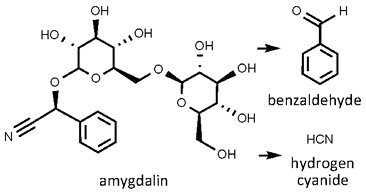 Prunus dulcis
Prunus dulcis
almond
Back to “Spices: almond (Prunus dulcis)s”
Prunus dulcis (Mill.) D.A. Webb [= P. amygdalis (L.) Batsch] (Rosaceae); amandel (Afrikaans); bian tao zi (Chinese); amandel (Dutch); amande (French); Mandel (German); badama (Hindi); mandorla (Italian); amondo (Japanese); amêndora (Portuguese); almendra (Spanish)
DESCRIPTION Almonds are seeds (nuts) borne within a bony or papery shell (endocarp) and surrounded by a fleshy outer layer (the mesocarp and exocarp). The seeds become ivory white when the reddish brown seed coat is removed and they are blanched, sliced, chopped, diced or ground to a paste. Sweet almonds (var. dulcis) have a delicious, sweet nutty taste and a weak almond aroma, while bitter almonds (var. amara) are extremely bitter (and poisonous) but have a strong and sweet-smelling, typical almond or marzipan aroma.1,2
THE PLANT A small tree with pale pink or white flowers and velvety fruits that resemble those of peaches (they are closely related)2 but dry out and split open at maturity.
ORIGIN Western Asia.1 Almonds have been cultivated for at least 3 000 years in the Near East, North Africa and southern Europe.1,2
CULTIVATION Unlike peaches, almonds are not self-fertile, so that two or more cross-pollinating cultivars have to be planted to ensure fruit set. Almonds are cultivated in practically all temperate regions of the world. The United States (California) has become a major producer.2
HARVESTING Almond fruits are hand-harvested (or by mechanical tree shakers) when the husks dry out. The seeds are then extracted and further processed.
CULINARY USES Almonds in one form or another are important flavourants, used since the Middle Ages to make almond soup, almond milk, almond butter, almond milk jelly (blancmange) and sweet desserts.3 They are still important in confectionery (cakes, biscuits, sweetmeats and sweets). Almond paste and marzipan, made from ground almonds mixed with sugar and egg whites are indispensable items, not only for the icing or filling of cakes but also for many types of sweets, sweetmeats (massepains), confectionery, breads, cakes, biscuits and pastries.3 Almonds are used in flavoured butters, sauces, couscous and meat dishes, especially fish and poultry stuffings.3 Bitter almonds, their essential oil or artificial almond essence may be used sparingly whenever an almond flavour is required. Italian amaretto is an example of an almond-flavoured liqueur.
FLAVOUR COMPOUNDS The typical almond flavour is due to benzaldehyde, a volatile compound that forms rapidly when amygdalin, the main cyanogenic glycoside in almonds, is broken down by enzymatic action. The process only happens when the seed is damaged or eaten, so that the enzymes become mixed with the amygdalin-rich cell contents. The process yields benzaldehyde, hydrogen cyanide (a toxic gas) and two molecules of sugar. Cold-pressed sweet almond oil is valuable as carrier oil in aromatherapy or as ingredient of cosmetics and creams.

NOTES Charoli seeds, obtained from a cultivated shrub (Buchanaria lanzan), are used in Indian and Pakistani cuisine to add an almond flavour to milk and milk-based desserts. The small, lentil-sized seeds are often roasted (toasted) to bring out the flavours before use as snack food or as ingredient of sauces and stews.
1. Mabberley, D.J. 2008. Mabberley’s plant-book (3rd ed.). Cambridge University Press, Cambridge.
2. Watkins, R. 1995. Cherry, plum, peach and almond. In: Smartt, J., Simmonds, N.W. (Eds), Evolution of crop plants (2nd ed.), pp. 423–428. Longman, London.
3. Larousse. 1999. The concise Larousse gastronomique. Hamlyn, London.